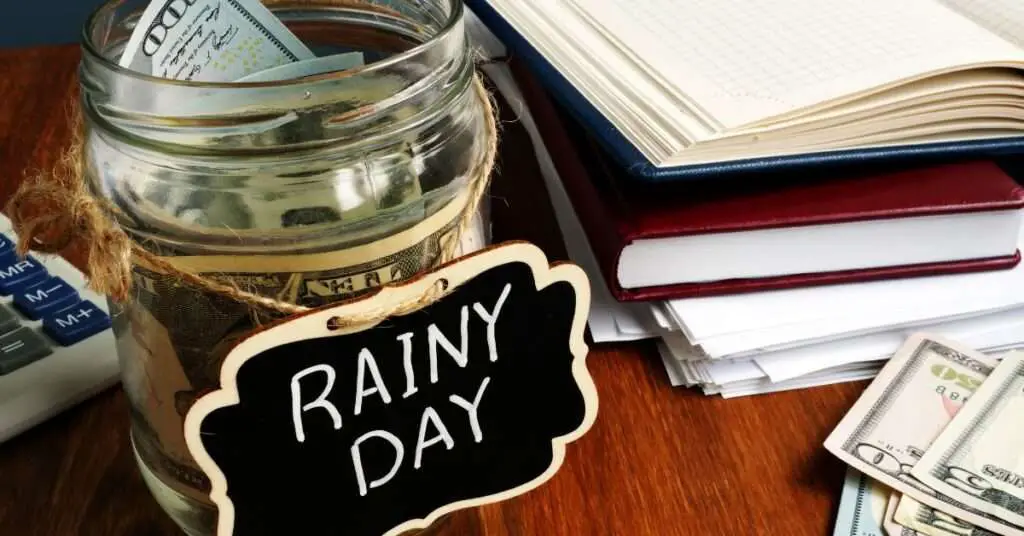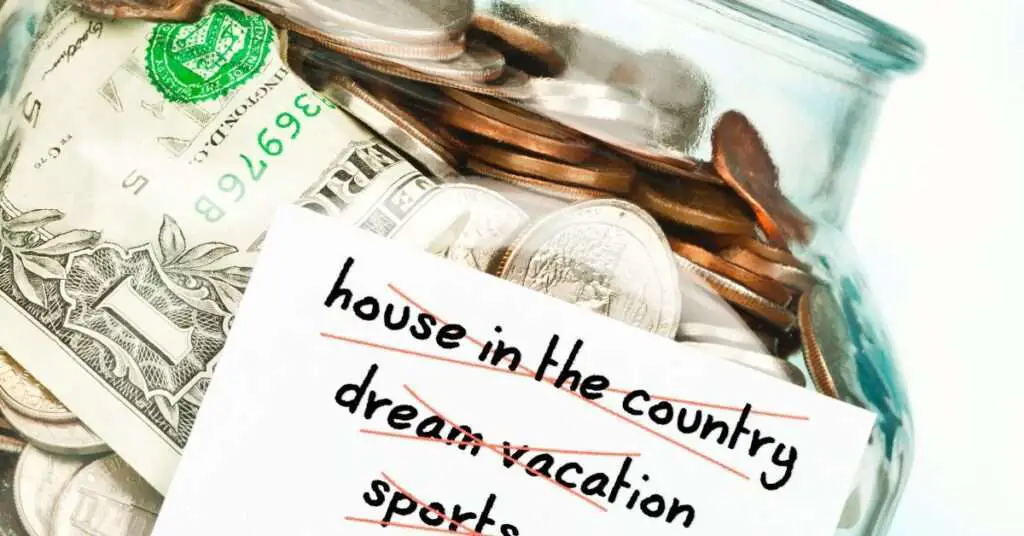What’s a rainy day fund? Picture it this way. You’re going about your business when life throws a metaphorical slippery banana peel your way. You slide and tumble, but you’ve got a cushion to soften the fall. That’s your rainy day fund!
If you’re catching up with us and need an introduction to a rainy day fund and how to save for it, I’ve got you covered. I previously wrote a blog post titled “How to Save for a Rainy Day Fund?” Feel free to give it a quick read to get up to speed. Once you’re all set, come back here, and let’s dive into where exactly to stash that rainy day fund.

Ideal Locations for your Rainy Day Fund
Alright, we’ve established that a rainy day fund is not just a good idea, but a financial necessity. Think of it as your financial umbrella, keeping you dry when financial storms brew. So, let’s talk about where to park this essential fund. And no, your old sock drawer doesn’t count.
A good home for your rainy day fund is a place that’s not only safe but also accessible. It needs to be there for you at a moment’s notice, like a superhero ready to swoop in and save the day.

Let’s consider the trusty savings account, your financial equivalent of a reliable neighbor. Always there, easy to tap into, it’s a popular choice.
Now, imagine Laura, an architect with an unusual fascination for polka dots. She keeps her rainy day fund in a high-yield savings account, an upgraded version of a standard savings account with better interest rates.
One unexpected day, her home decides to moonlight as a water park. Not ideal. But Laura isn’t worried. A few clicks, a quick transfer from her high-yield savings account to her checking account, and the roof repair is covered.

But savings accounts aren’t the only game in town. Money market accounts and short-term CDs (Certificate of Deposit) also have their charms.
Think of an unexpected expense hitting a hypothetical Company Y. If their emergency funds were tied up in long-term investments or (heaven forbid) stuffed inside the CEO’s teddy bear, they’d be in a jam. But with readily accessible funds, it’s merely a hiccup.
Consider diversifying with a short-term CD. Picture Sara, a pastry chef, who keeps part of her fund in a 3-month CD. When her oven bails on her right before a baking contest, she has her diversified fund to fall back on, saving the day (and the dough).
Money market funds are another option, offering potentially higher returns. Take Bob, a writer and vintage typewriter enthusiast. He keeps a portion of his fund in a money market fund, giving him the flexibility to seize unique opportunities, like adding a rare 1920s typewriter to his collection without disrupting his regular finances.

Let’s not forget Treasury Bills (T-Bills), backed by Uncle Sam himself. Alice, a comic book artist, uses T-Bills as part of her rainy day fund strategy. When her computer crashed unexpectedly, she didn’t need to dip into her credit. Instead, she cashed in some T-Bills, keeping her financial stability intact.
Lastly, there are Certificates of Deposit (CDs). Imagine Frank, a retired teacher, who puts part of his rainy day fund in a 6-month CD. He enjoys higher returns and maintains enough liquidity in his other accounts to cover unexpected costs.
Remember, diversifying the location of your rainy day fund provides a financial safety net. Each option has its unique advantages, and together, they form a robust, readily accessible fund that’s there for you when you need it.
Other Factors to Consider
So, you’ve cracked the ‘where’ of your rainy day fund. Good for you! But don’t get too comfortable; there’s more to this financial saga. Ever thought about the ‘how much’?
The amount you stash away for a rainy day is just as crucial as its safekeeping spot. Just like in a good recipe, balance is key.
The pros in suits, aka financial gurus, advise us to maintain 3-6 months’ worth of living expenses in our rainy day fund. Why, you ask? Think of it as a safety net, keeping you financially steady even if life decides to throw a surprise party.

Now let’s take a little imaginary trip to the corporate world. Say hello to Company A. Back in 2019, they suddenly found themselves needing extra capital – like a movie buff craving popcorn during a thriller. If they had a hefty reserve, this unexpected cost would be a hiccup, not a heart attack.
It works the same way for us folks too. Imagine you’re Bob, an artist who’s just started selling his work online. In 2021, Bob put $500 into the stock market, and voila, by 2023, it’s ballooned to $2000.
That’s great, but what if his laptop breaks down or there’s a sudden spike in art supply prices? That’s where the rainy day fund comes in, stepping up like a superhero, saving Bob from falling into debt.
Now, imagine if Bob hadn’t stashed away some funds and had to withdraw from his blossoming investment. He’d be like a kid forced to leave a candy shop early. Not a pretty picture, right?
So, remember, folks, where to keep your rainy day fund and how much to keep are two sides of the same coin. Balancing both ensure that you’re financially prepared, come rain or shine!
- Regular Expenses: This includes all your monthly recurring expenses like housing, groceries, bills, transportation, etc. Generally, it should ideally account for around 60% of your total income.
- Investments: This represents the part of your income that you put into different investment avenues like stocks, bonds, real estate, etc. A recommended allocation might be around 20% of your total income, but this can vary greatly depending on individual risk tolerance, financial goals, and other factors.
- Rainy Day Fund: You set aside money for unexpected expenses or financial emergencies. Like investments, around 20% of your income could go here, but the exact amount can depend on your financial situation and comfort level.
Conclusion and Next Steps
So, there you have it! A rainy day fund is your financial lifebuoy, and keeping it in a quickly accessible place, like a savings account, can be a wise choice.
Starting with the all-important assessment of your financial landscape – your income and expenses – the chart below provides a roadmap for setting a savings goal tailored to your specific circumstances. Crucially, it underscores the significance of selecting the right ‘home’ for your fund, balancing the twin needs of accessibility and growth.
As you journey down the flowchart, you’ll notice the repeated emphasis on consistent savings and mindful fund management. Highlighting scenarios where your rainy day fund could swoop in like a financial superhero, it brings the importance of this fund to life.
The chart ultimately distills the essence of a rainy day fund – a beacon of security offering you financial stability and peace of mind.
Like knowing the lyrics to your favorite 80’s song or the perfect amount of milk in your coffee, having a well-stocked rainy day fund just feels right. It gives you a sense of security. So, why not start building yours today?
FAQs
What should I do with my rainy day fund?
First off, it’s crucial to note that your rainy day fund is your financial safety net for unexpected expenses. These funds are not meant for investments, luxury purchases, or regular bills. They are reserved for financial emergencies only. Here’s a guide to managing your rainy day fund:
1. Save Regularly: The key to building and maintaining a substantial rainy day fund is consistency. Aim to put a specific portion of your income into this fund every month.
2. Store it Safely: Your rainy day fund should be placed in a safe and accessible place. This could be a savings account, money market account, or a short-term Certificate of Deposit (CD).
3. Let it Grow: Choose an account that offers interest. This way, your fund will slowly grow over time, even as it remains accessible.
4. Only Use for Emergencies: This can’t be stressed enough. Your rainy day fund is for financial emergencies like job loss, unexpected medical expenses, or urgent home repairs.
5. Replenish Used Funds: If you dip into your fund, prioritize replenishing it as soon as possible. This ensures you’ll have funds ready for the next unexpected event.
Remember, a rainy day fund provides peace of mind and financial security. Keep it safe, let it grow, and only use it when necessary. This way, your rainy day fund will always be ready to step in when life throws a financial curveball your way.
What is the difference between a rainy day fund and an emergency fund?
A rainy day fund and an emergency fund, while similar in purpose, are designed to cover different types of financial surprises. Here’s the basic difference:
1. Rainy Day Fund: A rainy day fund is designed for smaller, unexpected expenses that may come up in your day-to-day life. These could be things like a minor car repair, an unexpected medical bill, or a home appliance breaking down.
The rule of thumb is to have enough in this fund to cover small to medium financial hiccups, typically around $1,000 to $2,000.
2. Emergency Fund: On the other hand, an emergency fund is meant for larger financial emergencies that can significantly disrupt your income. This includes events such as job loss, a major medical emergency, or significant home repairs.
Financial experts typically recommend saving enough in this fund to cover 3-6 months’ worth of living expenses.
In essence, a rainy day fund is for smaller, more common unexpected expenses, while an emergency fund is there to protect you in the case of a significant financial disruption. Both funds are critical parts of a healthy personal finance plan, providing a safety net for life’s unpredictable moments.
How much rainy day fund should you have?
When it comes to setting up a rainy day fund, financial experts generally recommend that you aim to save enough to cover three to six months’ worth of living expenses. This includes costs such as rent or mortgage payments, groceries, utilities, transportation, and other necessities.
However, the exact amount can vary depending on your personal circumstances, including your income level, fixed expenses, and financial goals. You might need to save more if you have a higher income or more financial responsibilities.
If your income is less stable, such as if you’re a freelancer or self-employed, having a larger fund could provide more financial security.
In conclusion, while three to six months’ worth of expenses is a good general rule, assessing your situation and adjusting your savings goal is important.
Remember, the key purpose of a rainy day fund is to provide financial stability and peace of mind, so it’s worth taking the time to set a target that feels right for you.
Can we secure a rainy day fund from the government?
The concept of a rainy day fund generally refers to personal savings set aside to cover unexpected expenses or financial emergencies. As such, it is not something provided or secured by the government. Instead, it is a key part of individual or household financial planning.
However, it’s important to note that the government offers programs and services to help citizens during financial distress. These include unemployment benefits, social security, and various types of assistance programs.
While these services can provide essential support during tough times, they are not a substitute for having personal savings set aside in a rainy day fund.
In conclusion, a rainy day fund is a personal safety net you build over time rather than a benefit provided by the government. It’s essential to managing your finances and ensuring you’re prepared for unexpected costs.

